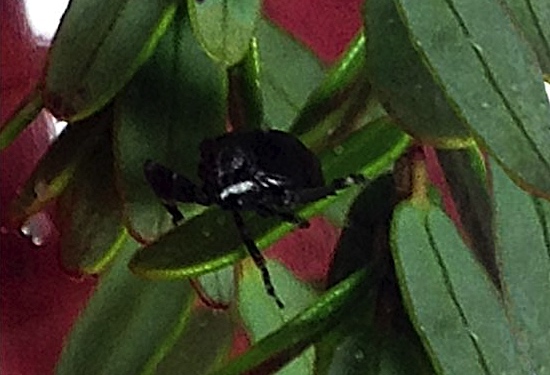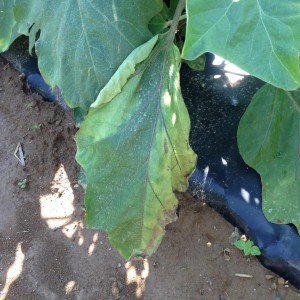Recently the cranberry toad bug, Phylloscelis atra (Figure 1), has become a problematic pest of cranberries in New Jersey. Toad bugs are hemipteran insects, similar to blunt-nosed leafhoppers, but belong to the Family Dictyopharidae (planthoppers) as opposed to leafhoppers, which belong to the family Cicadellidae.
Archives for July 2015
Potato | Tomato Disease Forecast 7-14-15
Click to View | Download Report 7-14-15
Potato Disease Forecasting Report
We will be tracking DSVs for Late blight development and calculating P-days for initiating the first early blight fungicide application.
The first late blight fungicide application is recommended once 18 DSVs accumulate from green row. Green row typically occurs around the first week in May in southern New Jersey. An early season application of a protectant fungicide such as mancozeb (Dithane, Manzate, Penncozeb) or Bravo (chlorothalonil) as soon the field is accessible is suggested. Please be vigilant and keep a look out for suspect late blight infections on young plants. No late blight has been reported in our region to date.
Remember the threshold for P-days is 300! Once 300 P-days is reached for your location early blight fungicide applications should be initiated. Growers who are interested in using this model should chose the location above that is closest in proximity to their farming operation and should regularly check the Cornell NEWA website (http://newa.cornell.edu/) where this information is compiled from. Click on Pests Forecasts from the menu, select your weather station, and click on tomato diseases, set accumulation start date and a table of daily and total DSVs will be generated.
Disease severity values (DSVs) for early blight, septoria leaf spot, and tomato anthracnose development are determined daily based on leaf wetness (due to rainfall, dew) and air temperature.
On a daily basis DSV values can range from 0 to 4 where 0 = no chance for disease development to 4 = high chance for disease development.
DSVs are accumulated during the production season.Fungicide applications are based on an individually determined DSV threshold. The first fungicide application for the control of these three diseases is not warranted until 35 DSVs have accumulated from your transplanting date. After that, growers can base fungicide applications on different DSV thresholds.
Intro to Organic Vegetable Production Field Day from Penn State, Aug 6, 2015
Location
Good Work Farm
4791 Rock Road
Zionsville, PA 18092Date: August 6, 2015 from 4 to 7 pm
4:00 PM Farm Tour
4:45 PM Scouting and Identification Exercise
5:45 PM Disease Management and Discussion
6:30 PM DinnerRegistration
This field day is part of the Introduction to Organic Vegetable Production series. No pre-registration is required. Walk-in to join us. $10 walk-in fee covers dinner and materials.
Penn State Extension is offering An Introduction to Organic Vegetable Production Field Day focusing on plant disease scouting, identification, and management on the evening of August 6th at Good Work Farm in Zionsville, PA located about an hour north of Philadelphia. For more information see Organic Vegetable Production Field Day.
Of Note from UDel: Late blight Look-a-like in Potato & Late blight Lineages
Two important topics were addressed by Dr. Nathan Kleczewski, Extension Specialist in Plant Pathology at the University of Delaware this week in the Weekly Crop Update.
- Phytophthora nictotiana, a late blight look-a-like, was found on potato in DE
- Explaining Late blight lineages in relationship to thier potential host and sensitivity to mefenoxam
We have on occasion detected Phytophthora nicotiana on potato in southern New Jersey when wet weather conditions have been prolonged. The good news is that P. nicotiana, although it looks like Late blight, does not show anywhere near the destructiveness that comes with Late blight.
Last week Late blight, Phytophthora infestans, (US23) was found in tomato in Northern New Jersey. US23 has been the predominant genotype found throughout the region during the past few years. Why is knowing the genotype so important? US23 will infect both tomato and potato and has been shown be sensitive or to have intermediate-sensitivity to mefenoxam (i.e., Ridomil Gold). Knowing that US23 is present in New Jersey should put all tomato and potato growers on high alert and everyone should be scouting on a regular basis. All tomato and potato growers should initiate standard protectant fungicide programs if they already haven’t done so.
Verticillium Wilt in Eggplant
Verticillium wilt is a common soil-borne fungal pathogen that once it has infested soil can remain for a very long time. Verticillium wilt is caused by either Verticillium albo-atrium or Verticillium dahlia and has a wide host range (over 200 plant species). Both pathogens can survive (overwinter) as microsclerotia in the soil. Verticillium wilt prefers cooler weather and drier soils and can be more severe in neutral to alkaline soils. Solanaceous weeds such as Nightshade may harbor the pathogen.
Leaf Mold in Tomato
Leaf mold (formerly Fulvia fulva) has been confirmed in field-grown tomatoes in Cape May County.
Leaf mold occasionally appears in high tunnel or greenhouse tomato production in New Jersey. However, under ideal conditions the disease will develop in field-grown crops. The fungus will cause infection under prolonged periods leaf wetness and when relative humidity remains above 85%. If relative humidity is below 85% the disease will not occur. The pathogen can survive (overwinter) as a saprophyte on crop debris or as sclerotia in the soil. Conidia (spores) of the fungus can also survive up to one year in the soil.

Symptoms of leaf mold on infected tomato plant. Note bright yellow leaves and olive-green spores developing on undersides of leaves.


